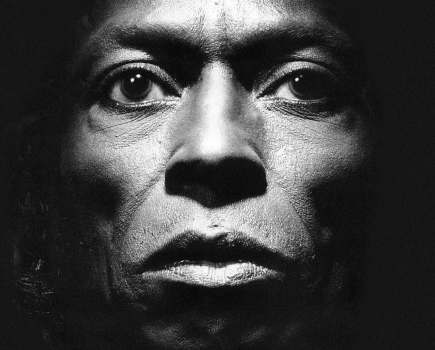Icons of photography Three Boys at Lake Tanganyika by Martin Munkácsi
Martin Munkácsi?s dynamic 1930s photograph inspired Henri Cartier-Bresson, who in turn influenced generations of photojournalists. David Clark finds out what makes the image so special
 ?Liberia, 1930?. Martin Munkácsi is reputed to have taken this image on the shores of Lake Tanganyika, which is some 2,000 miles from Liberia
?Liberia, 1930?. Martin Munkácsi is reputed to have taken this image on the shores of Lake Tanganyika, which is some 2,000 miles from Liberia
© Estate of Martin Munkacsi, Courtesy Howard Greenberg Gallery, NYC
Martin Munkácsi?s ?Boys at Lake Tanganyika? is the most famous image by someone who, at the height of his career, was one of the most highly paid photographers in the world. While undoubtedly a brilliant photograph in its own right, it partly owes its iconic status to the high praise given to it by Henri Cartier-Bresson.
?In 1932, I saw a photograph by Martin Munkácsi of three black children running into the sea and I must say that it is that
very photograph which was for me the spark that set fire to fireworks? and made me suddenly realise that photography could reach eternity through the moment,? said Cartier-Bresson. ?I couldn?t believe such a thing could be caught with the camera. I said damn it, I took my camera and went out into the street.?
Munkácsi?s picture was made possible by the technological advances and new stylistic approaches being pioneered in the late 1920s and early ?30s. This was a period of rapid change in photography. New cameras such as the Leica I introduced in 1925, combined with the increased sensitivity of film emulsion, were making new kinds of images possible.
At the same time, photography was moving away from the painterly ?pictorialist? images that dominated the early years of the century and into the sharper, more distinctively photographic style of ?straight? photography. When the image was shot, Munkácsi (born Márton Mermelstein in 1896) was 34 and one of the most accomplished magazine photographers working in Germany at that time. He had moved there from his native Hungary in 1928 and was regularly working on assignments for the leading German magazine Berliner Illustrirte Zeitung (BIZ). He later went on to have a major influence on fashion photography, working for magazines including Harper?s Bazaar and Life after emigrating to the USA in 1934.
 Martin Munkácsi taking a shot of a diver for Harper?s Bazaar, at Long Island, USA,1935 © Estate of Martin Munkacsi, Courtesy Howard Greenberg Gallery, NYC
Martin Munkácsi taking a shot of a diver for Harper?s Bazaar, at Long Island, USA,1935 © Estate of Martin Munkacsi, Courtesy Howard Greenberg Gallery, NYC
His approach to photography was summed up in an article called Think While You Shoot, published in a 1935 issue of Harper?s Bazaar. ?Never pose your subjects. Let them move about naturally. All great photographs today are snapshots,? he wrote. ?Take back views. Take running views. Our cameras today allow us one-thousandth of a second. Pick unexpected angles, but never without reason.?
?Boys at Lake Tanganyika? shows the graceful forms of three black boys in near silhouette against the white surf as they run towards the water. It captures a sense of excitement and freedom, and although shot with the boys running at speed, all the elements combine serendipitously. Capturing movement was central to Munkácsi?s style; he often photographed people running or jumping and frequently used beaches as his location.
Munkácsi?s cropping is tight, though not so severe as to exclude the hand of a fourth boy on the left side of the frame. It?s easy to see how the energy in the image would appeal to Cartier-Bresson, who went on to capture many such beautifully timed ?decisive moments?. Nevertheless, it?s worth noting that the image is perhaps not all it seems.
First, the location is open to question. Munkácsi is reputed to have photographed the scene at Lake Tanganyika in 1930, while on assignment in Africa for BIZ. The job involved documenting how traditional life in Liberia was changing in the 20th century. However, Lake Tanganyika is located between Burundi, Democratic Republic of the Congo, Tanzania and Zambia, and is more than 2,000 miles from Liberia.
To add to the confusion, the picture is sometimes simply titled ?Liberia, 1930?. Whatever the true location, the photograph did not fit in with the documentary nature of Munkácsi?s other images of Liberia. It was not published until the following
year, in the French arts magazine Arts et Métiers Graphiques. It is also perhaps not the direct product of the age of the miniature camera. The picture?s informality suggests it was shot using one of the new generation of 35mm cameras, as used by Cartier-Bresson and other photojournalists of the period. However, Munkácsi rejected the use of cameras that produced anything smaller than a 9x12cm negative and it seems very likely that this image was shot on large-format equipment.
Finally, although Munkácsi?s photograph has rightly been praised for its composition, it?s unclear quite how much the framing was altered in the darkroom. He admitted to often severely cropping his images, declaring in 1935 that, ?The photograph you see signed with my own name is sometimes only a fraction of the original photograph.? The difficulty of capturing the boys moving at speed on the cumbersome large-format cameras Munkácsi preferred makes it possible that the photograph we know was only part of the original image.
Nevertheless, despite uncertainty about where and how it was created, Munkácsi?s photograph is today considered a landmark in the history of photography. It not only ignited the photography of Cartier-Bresson, but, through Cartier-Bresson?s influence, also countless other photojournalists in subsequent generations.
 Summer Camp, near Bad Kissingen, Germany, 1929© Estate of Martin Munkacsi, Courtesy Howard Greenberg Gallery, NYC
Summer Camp, near Bad Kissingen, Germany, 1929© Estate of Martin Munkacsi, Courtesy Howard Greenberg Gallery, NYC
Events of 1930
- 18 February Clyde Tombaugh, an American astronomer, confirms the existence of Pluto
- 12 March In India, Mahatma Gandhi begins the Salt March, a 200-mile protest march against the British monopoly on salt. It begins a period of civil disobedience that leads to the Indian independence movement
- 6 May An earthquake measuring 7.2 on the Richter scale occurs in Salmas, Persia (now Iran), resulting in more than 4,000 deaths
- 24 May Pioneer aviator Amy Johnson becomes the first woman to make the 11,000-mile solo flight from England to Australia
- 13 July The inaugural FIFA Football World Cup begins in Uruguay
- 14 September In the German elections, the National Socialists continue their rise to power and become Germany?s second largest party
- 5 October The British Airship R101 crashes in France on its maiden voyage killing 48 people
- 2 November Haile Selassie is crowned the Emperor of Ethiopia. His reign lasts until he is deposed in 1974
- 2 December US President Herbert Hoover tries to encourage growth in the economy during the Great Depression by requesting Congress to approve a $150million public works programme
Recommended Resources
Books The best book about Munkácsi currently available is Martin Munkácsi,
edited by FC Gundlach and published by Thames & Hudson. It contains more than 300 images from throughout his career, plus biographical essays.
Websites Useful information and links on Munkácsi can be found on www.wikipedia.com and www.answers.com. A number of Munkácsi?s images can be seen on the Howard Greenberg Gallery website at www.howardgreenberg.com.
to inquire about purchasing from the Howard Greenberg Gallery please contact
41 East 57th Street
Suite 1406
New York, NY 10022
tel. 212 334 0010 fax. 212 941 7479






